Hey beautiful mothers out there, today let’s dive into the important topic of how to use Telament colic drops when breastfeeding. We all know that dealing with a baby’s tummy troubles can be tough, but colic drops can be a savior when it comes to easing those discomforts like wind, stomach issues, and even gas and bloating. So, let’s understand how to make the most of these colic drops while you’re breastfeeding.
What are Telament Colic Drops?
Colic drops are a magical solution to soothe your baby’s tummy woes. They are designed to help with issues like excessive crying, fussiness, and gassiness that are often associated with colic. These drops usually contain natural ingredients that work together to provide relief to your little one.
Breastfeeding and Telament Colic Drops: A Winning Combo
If you’re breastfeeding your baby, you might wonder how to incorporate colic drops into your routine. Well, the good news is that colic drops can be easily given alongside breastfeeding. You don’t need to worry about interrupting your breastfeeding journey.
The Right Timing
Timing is key when using colic drops. It’s best to administer them before or after breastfeeding, rather than during the feeding session. This ensures that your baby gets the full benefit of both the breast milk and the colic drops.
How to Use Telament Colic Drops When Breastfeeding
In general, you would use 8 or 12 drops of the colic solution in water or liquid when giving babies or smaller children.
The Telament colic drops can also be given to older children which is 2.5ml.
Before Breastfeeding:
Administering the colic drops before breastfeeding can help ease any discomfort your baby might experience during or after feeding. This way, your baby’s tummy will already be soothed when they start nursing.
After Breastfeeding:
Giving colic drops after breastfeeding can aid in digestion and prevent potential tummy troubles later. It’s like a gentle way to wrap up the feeding session.
Administering Telament Colic Drops
Using colic drops is a breeze. Most often, these drops come with a dropper for easy administration. Gently squeeze the dropper to release the recommended number of drops into your baby’s mouth. Make sure to follow the instructions provided on the packaging or as advised by your pediatrician.

How Many Times Can I Give My Baby Colic Drops?
You can give your baby colic drops six times a day as the maximum dosage.
Telament Drops for Newborns Dosage
You can use 8 to 12 drops of colic for newborns.
Telament Drops Side Effects
Side effects of Telament drops include:
- Flatulence
- Constipation
- Diarrhea
- Distension
Consult Your Pediatrician
As every baby is unique, it’s always a good idea to consult your pediatrician before incorporating colic drops into your routine. They can guide you on the appropriate dosage and the best times to administer the drops based on your baby’s individual needs.
Storing and Handling
Proper storage and handling of colic drops are essential to ensure their effectiveness. Keep the drops in a cool, dry place, and make sure the cap is tightly closed after each use. Always check the expiration date before using the drops.

Observing the Benefits
Using colic drops while breastfeeding can bring relief to both you and your baby. You might notice your little one becoming less fussy, experiencing fewer episodes of colic-related discomfort, and enjoying more peaceful feeding sessions.
Telament Colic Drops Tips for Comfort
While colic drops can work wonders, a holistic approach can further enhance your baby’s comfort:
Burp Your Baby: Gently burping your baby during and after feeding can help release any trapped gas and reduce discomfort.
Hold Your Baby Upright: Holding your baby in an upright position for a little while after feeding can aid in digestion and prevent gas buildup.
Watch Your Diet: If you’re breastfeeding, certain foods in your diet might contribute to your baby’s gassiness. Pay attention to your diet and observe if any specific foods seem to trigger discomfort in your baby.
Telament Colic Drops vs Gripe Water
Telament Colic Drops and gripe water are two commonly used over-the-counter remedies designed to alleviate colic symptoms in infants, particularly addressing issues such as gas, indigestion, and discomfort.
Telament Colic Drops:
Telament Colic Drops typically contain simethicone as a key active ingredient. Simethicone is known for its ability to break down gas bubbles in the stomach, making it easier for the baby to pass gas. It is generally considered safe for use in infants and is often recommended by healthcare professionals. Telament Colic Drops are often administered orally, either directly into the baby’s mouth or by mixing with breast milk or formula. It’s essential to follow the recommended dosage guidelines provided by the manufacturer or a healthcare professional.
Gripe Water:
Gripe water, on the other hand, is a traditional remedy that has been used for generations to ease colic symptoms. The ingredients in gripe water can vary, but common components include herbs like fennel, ginger, chamomile, and sodium bicarbonate. These ingredients are believed to have soothing properties and aid in digestion. Gripe water is usually administered orally, and some formulations may also include a sweetener to make it more palatable for infants.
The choice between Telament Colic Drops and gripe water often depends on individual preferences, the baby’s response to the remedy, and any specific recommendations from healthcare providers. While both options aim to provide relief from colic symptoms, it’s crucial for parents to consult with pediatricians before introducing any new remedy to their infants. Pediatricians can offer guidance based on the baby’s health, potential allergies, and the overall effectiveness of the chosen remedy.
In summary, Telament Colic Drops and gripe water serve similar purposes in alleviating colic-related discomfort in infants. Parents should exercise caution, follow recommended dosages, and seek professional advice to ensure the chosen remedy aligns with the baby’s needs and health conditions.
Conclusion
Dear mothers, the journey of breastfeeding can sometimes come with its challenges, but with the help of colic drops, those challenges can be managed. Remember, you’re not alone in this, and seeking advice from your healthcare provider can provide you with the best guidance for your baby’s unique needs. So, here’s to happy breastfeeding and happy, colic-free babies!

